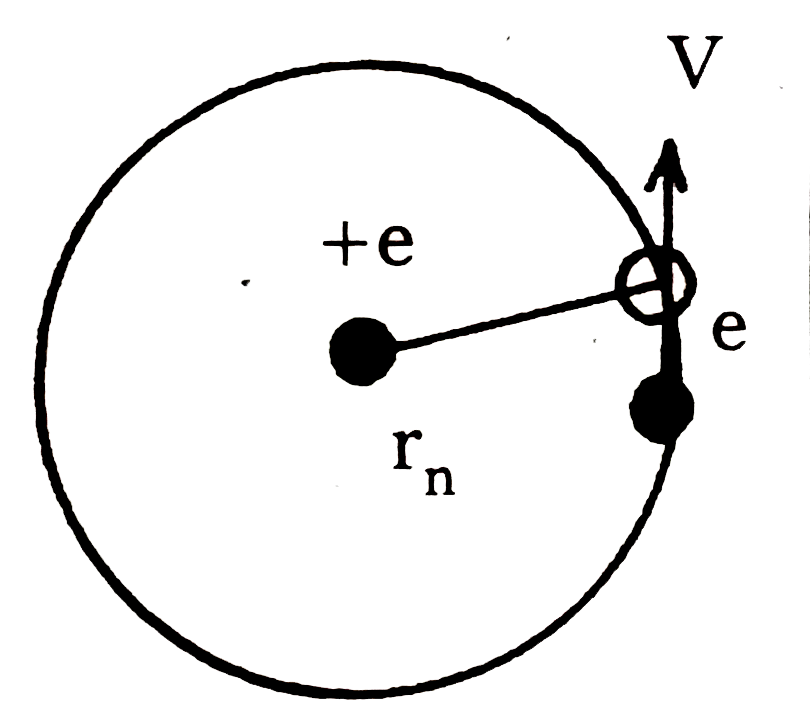State the basic postulates of Bohr's theory of atomic spectra. Hence obtain an expression for the radius of orbit and the energy of orbital electron in a hydrogen atom.
a) Basic postulates of Bohr's theory are
1) The electron revolves round a nucleus is an atom in various orbits known as stationary orbits. The electrons can not emit radiation when moving in their own stationary levels.
2) The electron can revolve round the nucleus only in allowed orbits whose angular momentum is the integral multiple of h2π
i.e., mvnrn=nh2π →(1)
where n=1,2,3....
3) If an electron jumps from higher energy (E2) orbit to the lower energy (E1) orbit, the difference of energy is radiated in the form of radiation.
i.e., E=hv=E2−E1⇒v=E2−E1h →(2)
b) Energy of emitted radiation : in hydrogen atom, a single electron of charge-e, revolves around the nucleus of charge e in a circular orbit of radius rn.
1) K.E. of electron : For the electron to be in circular orbit, centripetal force = The electrostatic force of attraction between the electron and nucleus
From Coulomb's law, mv2nrn=Ke2r2n →(3)
where K=14πε0 →(4)
mv2n=Ke2rn →(5)
mv2rn=Ke2 →(6)
Dividing (5) by (1), vn=Ke2×2πnh
From (3), kinetic energy K=12mv2n=Ke22rn
2) Potential energy of electron :
P.E. of electron, U=Kern×−e [∵W=14πε0qd×−Q]
∴U=−Ke2rn
3) Radius of the oribit : Substituting the value of (6) in (2).
mrn(n2h24π2r2nm2)=Ke2r2n
rn=n2h24π2mKe2 →(1)
∴ rn=0.53n2
4) Total energy (En) : Revolving electron posses K.E. as well as P.E.
i.e., En=K+U=Ke22t−Ke2t=−Ke22r
⇒En=−Ke22n2h2×4π2mKe2 [∴ from (7)]
But K=14πε0
∴En=−me48ε20n2h2

Related Playlists
- BOOK - VIKRAM PUBLICATION ( ANDHRA PUBLICATION)CHAPTER - ATOMSEXERCISE - TEXTUAL EXERCISES12videos
ATOMS
- BOOK - VIKRAM PUBLICATION ( ANDHRA PUBLICATION)CHAPTER - ATOMSEXERCISE - ADDITIONAL EXERCISES24videos
ATOMS
- BOOK - VIKRAM PUBLICATION ( ANDHRA PUBLICATION)CHAPTER - ATOMSEXERCISE - short answer question9videos
ATOMS
- BOOK - VIKRAM PUBLICATION ( ANDHRA PUBLICATION)CHAPTER - ANDHRA PRADESH MARCH-2019EXERCISE - SECTION-C3videos
ANDHRA PRADESH MARCH-2019
- BOOK - VIKRAM PUBLICATION ( ANDHRA PUBLICATION)CHAPTER - COMMUNICATION SYSTEMEXERCISE - TEXTUAL EXERCISES8videos
COMMUNICATION SYSTEM
Similar Questions
Obtain an expression for the radius of Bohr orbit for H atom.
View SolutionThe expression for Bohr radius of nth orbit of an atoms is
View SolutionUsing Bohr's atomic model, derive the expression for the radius of nth orbit of the revolviting electron in a hydrogen atom.
View SolutionUsing Bohr's postulates obtain the expression for the radius of the nthe orbit in hydrogen atom.
View SolutionState the postulates of Bohr's theory of hydrogen atom. Write the necessary equations.
View SolutionOn the basis of Bohr.s theory, derive an expression for the radius of the nth orbit of an electron of hydrogen atom.
View SolutionState the postulates of Bohr's theory of hydrogen atom. Write the necessary equations.
View SolutionDerive the expression for the radius of nth Bohr's orbit in Hydrogen atom.
View SolutionDerive an expression for the radius of nth Bohr’s orbit in Hydrogen atom.
View SolutionDerive an expression for the radius of nth Bohr’s orbit in Hydrogen atom.
View Solution

